Tannic Acid Market Insights 2025, Analysis and Forecast to 2030, by Manufacturers, Regions, Technology, Application
- Single User License (1 Users) $ 3,200
- Team License (2~5 Users) $ 4,200
- Corporate License (>5 Users) $ 5,200
Introduction
Tannic Acid, a naturally occurring polyphenolic compound extracted from plant sources such as gallnuts, tara pods, and oak bark, is a versatile chemical with widespread applications across multiple industries. Known for its astringent, antioxidant, and antimicrobial properties, it serves as a critical ingredient in sectors ranging from food and beverage to leather production, pharmaceuticals, and animal feed. The compound’s ability to bind with proteins and metal ions enhances its utility in processes like leather tanning, water purification, and metallurgical extraction. Its natural origin aligns with the growing global demand for sustainable and eco-friendly materials, positioning it as a preferred alternative to synthetic additives in various applications.
The Tannic Acid market is characterized by its niche yet steady growth, driven by its multifunctional nature and the expansion of downstream industries such as livestock farming, food processing, and industrial manufacturing. The global market is projected to reach a valuation of 50-100 million USD by 2025, with an estimated compound annual growth rate (CAGR) of 2.7%-4.5% through 2030. This moderate growth reflects a balance between increasing demand in emerging economies and challenges posed by substitutes and regulatory constraints in mature markets. The market’s reliance on plant-based raw materials and its concentration of production in regions with abundant natural resources, particularly Asia, further define its dynamics.
Regional Analysis
The Tannic Acid market exhibits distinct regional trends influenced by industrial activity, consumer preferences, and agricultural capabilities:
Asia Pacific: Growth is estimated at 3.0%-5.0%, with China leading as the largest producer and consumer due to its vast plant resources and robust leather and feed industries. India also contributes through rising demand in food processing and textiles. The region’s rapid industrialization and focus on sustainable additives drive market expansion.
Europe: Projected growth ranges from 2.0%-4.0%, with countries like Italy and Germany supporting demand through leather tanning and pharmaceutical applications. The region’s stringent regulations on natural ingredients bolster its use, though growth is tempered by market maturity.
North America: Anticipated growth falls between 2.5%-4.5%, driven by the United States’ food and beverage sector and growing interest in natural preservatives. The market benefits from advanced manufacturing but faces competition from synthetic alternatives.
Asia Pacific stands out as the fastest-growing region, fueled by China’s industrial scale, while Europe and North America maintain steady demand in specialized applications.
Application Analysis
Tannic Acid’s diverse applications contribute to its market stability, with growth varying by segment:
Feed: Growth is estimated at 3.5%-5.5%. Hydrolyzed tannins from plant extracts offer antibacterial and immune-boosting benefits, making them a popular additive in swine, cattle, sheep, and poultry feed. As a natural alternative to antibiotics, this segment sees robust demand, particularly in Asia, where feed production exceeds 2-2.5 billion tons annually.
Food & Beverage: Projected growth ranges from 2.5%-4.5%. Tannic Acid serves as a clarifier, decolorizer, and antioxidant in brewing, edible oils, and condiments like soy sauce and vinegar. Its role in flavor enhancement and preservation aligns with the trend toward clean-label products.
Leather: Growth is anticipated at 2.0%-4.0%. Used in tanning to improve leather durability, this traditional application remains significant in regions like Europe and Asia, despite competition from synthetic agents.
Dye: Expected growth is 1.5%-3.5%. Tannic Acid enhances flocking effects in textiles, with steady demand tied to apparel production in emerging markets.
Pharmaceutical: Growth ranges from 2.5%-4.5%. Its antimicrobial and astringent properties support its use in drug formulations and topical treatments, with potential growth in natural health products.
Others: Growth is estimated at 1.5%-3.5%, including water treatment and metallurgy, where Tannic Acid’s chelating abilities aid in purification and metal extraction.
Feed and food & beverage applications lead growth, reflecting global shifts toward sustainable additives, while leather and dye maintain historical relevance.
Key Market Players
The Tannic Acid market features a mix of established and regional producers:
Silvateam S.p.a.: An Italian company, it specializes in plant-based tannins for leather, food, and feed industries, with a strong global presence.
Wufeng Chicheng Biotech Co. Ltd.: A Chinese firm with a capacity of 9,500 tons, it focuses on feed and industrial applications, generating significant revenue in Asia.
Jiurui Biology & Chemistry Co. Ltd.: Operating at 1,200 tons capacity, this Chinese producer targets pharmaceutical and food-grade Tannic Acid markets.
Hubei Tianxin Biotech Co. Ltd.: Based in China, it supplies Tannic Acid for feed and industrial uses, leveraging local raw materials.
Gallotannin Co. Ltd.: A player focused on high-purity Tannic Acid for specialized applications like pharmaceuticals.
Deyang Tara Biotechnology Co. Ltd.: A Chinese company emphasizing tara-derived Tannic Acid for food and feed sectors.
Hunan Gomeet Biotechnology Co. Ltd.: A regional producer catering to China’s growing demand in multiple applications.
China dominates production, with firms like Wufeng Chicheng and Jiurui Biology leading capacity expansions.
Porter’s Five Forces Analysis
Threat of New Entrants: Moderate. Entry barriers include access to raw materials, technical expertise in extraction, and established customer relationships, though low capital requirements in some regions encourage new players.
Threat of Substitutes: High. Synthetic alternatives in leather tanning, antibiotics in feed, and chemical preservatives in food pose significant competition, pressuring Tannic Acid’s market share.
Bargaining Power of Buyers: Moderate to High. Large buyers in feed and leather industries, such as livestock firms and tanneries, exert pricing pressure due to the availability of substitutes and concentrated demand.
Bargaining Power of Suppliers: Moderate. Suppliers of plant materials hold leverage due to regional availability, but large producers mitigate this through vertical integration or diversified sourcing.
Competitive Rivalry: Moderate. A handful of key players compete on quality, capacity, and application diversity, with rivalry intensified by price sensitivity in commoditized segments like feed.
Market Opportunities and Challenges
Opportunities:
The shift toward antibiotic-free feed additives presents a significant growth avenue, particularly in Asia Pacific, where Tannic Acid’s natural benefits align with regulatory and consumer trends.
Rising demand for clean-label food and beverage products offers potential in North America and Europe, where Tannic Acid’s antioxidant properties enhance product appeal.
Expansion in industrial applications, such as water treatment and metallurgy, could diversify revenue streams, especially in emerging markets with infrastructure needs.
Planned capacity increases, like Guangdong Yingsaite’s 2,000-ton feed-grade project by 2025, signal confidence in sustained demand.
Challenges:
Competition from synthetic substitutes threatens Tannic Acid’s dominance in leather, feed, and food applications, requiring continuous innovation to maintain relevance.
Fluctuations in raw material availability, tied to agricultural yields, could disrupt supply chains and increase costs, particularly for smaller producers.
Regulatory hurdles in pharmaceuticals and food sectors, especially in Europe, demand compliance with stringent safety standards, potentially slowing market entry for new applications.
Chapter 1 Executive Summary
Chapter 2 Abbreviation and Acronyms
Chapter 3 Preface
3.1 Research Scope
3.2 Research Sources
3.2.1 Data Sources
3.2.2 Assumptions
3.3 Research Method
Chapter 4 Market Landscape
4.1 Market Overview
4.2 Classification/Types
4.3 Application/End Users
Chapter 5 Market Trend Analysis
5.1 Introduction
5.2 Drivers
5.3 Restraints
5.4 Opportunities
5.5 Threats
Chapter 6 Industry Chain Analysis
6.1 Upstream/Suppliers Analysis
6.2 Tannic Acid Analysis
6.2.1 Technology Analysis
6.2.2 Cost Analysis
6.2.3 Market Channel Analysis
6.3 Downstream Buyers/End Users
Chapter 7 Latest Market Dynamics
7.1 Latest News
7.2 Merger and Acquisition
7.3 Planned/Future Project
7.4 Policy Dynamics
Chapter 8 Trading Analysis
8.1 Export of Tannic Acid by Region
8.2 Import of Tannic Acid by Region
8.3 Balance of Trade
Chapter 9 Historical and Forecast Tannic Acid Market in North America (2020-2030)
9.1 Tannic Acid Market Size
9.2 Tannic Acid Demand by End Use
9.3 Competition by Players/Suppliers
9.4 Type Segmentation and Price
9.5 Key Countries Analysis
9.5.1 United States
9.5.2 Canada
9.5.3 Mexico
Chapter 10 Historical and Forecast Tannic Acid Market in South America (2020-2030)
10.1 Tannic Acid Market Size
10.2 Tannic Acid Demand by End Use
10.3 Competition by Players/Suppliers
10.4 Type Segmentation and Price
10.5 Key Countries Analysis
10.5.1 Brazil
10.5.2 Argentina
10.5.3 Chile
10.5.4 Peru
Chapter 11 Historical and Forecast Tannic Acid Market in Asia & Pacific (2020-2030)
11.1 Tannic Acid Market Size
11.2 Tannic Acid Demand by End Use
11.3 Competition by Players/Suppliers
11.4 Type Segmentation and Price
11.5 Key Countries Analysis
11.5.1 China
11.5.2 India
11.5.3 Japan
11.5.4 South Korea
11.5.5 Asean
11.5.6 Australia
Chapter 12 Historical and Forecast Tannic Acid Market in Europe (2020-2030)
12.1 Tannic Acid Market Size
12.2 Tannic Acid Demand by End Use
12.3 Competition by Players/Suppliers
12.4 Type Segmentation and Price
12.5 Key Countries Analysis
12.5.1 Germany
12.5.2 France
12.5.3 United Kingdom
12.5.4 Italy
12.5.5 Spain
12.5.6 Belgium
12.5.7 Netherlands
12.5.8 Austria
12.5.9 Poland
12.5.10 Russia
Chapter 13 Historical and Forecast Tannic Acid Market in MEA (2020-2030)
13.1 Tannic Acid Market Size
13.2 Tannic Acid Demand by End Use
13.3 Competition by Players/Suppliers
13.4 Type Segmentation and Price
13.5 Key Countries Analysis
13.5.1 Egypt
13.5.2 Israel
13.5.3 South Africa
13.5.4 Gulf Cooperation Council Countries
13.5.5 Turkey
Chapter 14 Summary For Global Tannic Acid Market (2020-2030)
14.1 Tannic Acid Market Size
14.2 Tannic Acid Demand by End Use
14.3 Competition by Players/Suppliers
14.4 Type Segmentation and Price
Chapter 15 Global Tannic Acid Market Forecast (2021-2026)
15.1 Tannic Acid Market Size Forecast
15.2 Tannic Acid Demand Forecast
15.3 Competition by Players/Suppliers
15.4 Type Segmentation and Price Forecast
Chapter 16 Analysis of Global Key Vendors
15.1 Silvateam S.p.a.
15.1.1 Company Profile
15.1.2 Main Business and Tannic Acid Information
15.1.3 SWOT Analysis of Silvateam S.p.a.
15.1.4 Silvateam S.p.a. Tannic Acid Sales, Revenue, Price and Gross Margin (2020-2025)
15.2 Wufeng Chicheng Biotech Co. Ltd
15.2.1 Company Profile
15.2.2 Main Business and Tannic Acid Information
15.2.3 SWOT Analysis of Wufeng Chicheng Biotech Co. Ltd
15.2.4 Wufeng Chicheng Biotech Co. Ltd Tannic Acid Sales, Revenue, Price and Gross Margin (2020-2025)
15.3 Jiurui Biology & Chemistry Co. Ltd
15.3.1 Company Profile
15.3.2 Main Business and Tannic Acid Information
15.3.3 SWOT Analysis of Jiurui Biology & Chemistry Co. Ltd
15.3.4 Jiurui Biology & Chemistry Co. Ltd Tannic Acid Sales, Revenue, Price and Gross Margin (2020-2025)
15.4 Hubei Tianxin Biotech Co. Ltd.
15.4.1 Company Profile
15.4.2 Main Business and Tannic Acid Information
15.4.3 SWOT Analysis of Hubei Tianxin Biotech Co. Ltd.
15.4.4 Hubei Tianxin Biotech Co. Ltd. Tannic Acid Sales, Revenue, Price and Gross Margin (2020-2025)
15.5 Gallotannin Co. Ltd
15.5.1 Company Profile
15.5.2 Main Business and Tannic Acid Information
15.5.3 SWOT Analysis of Gallotannin Co. Ltd
15.5.4 Gallotannin Co. Ltd Tannic Acid Sales, Revenue, Price and Gross Margin (2020-2025)
15.6 Deyang Tara Biotechnology Co. Ltd
15.6.1 Company Profile
15.6.2 Main Business and Tannic Acid Information
15.6.3 SWOT Analysis of Deyang Tara Biotechnology Co. Ltd
15.6.4 Deyang Tara Biotechnology Co. Ltd Tannic Acid Sales, Revenue, Price and Gross Margin (2020-2025)
Please ask for sample pages for full companies list
Table Research Scope Of Tannic Acid Report
Table Data Sources Of Tannic Acid Report
Table Major Assumptions Of Tannic Acid Report
Table Tannic Acid Classification
Table Tannic Acid Applications List
Table Drivers Of Tannic Acid Market
Table Restraints Of Tannic Acid Market
Table Opportunities Of Tannic Acid Market
Table Threats Of Tannic Acid Market
Table Raw Materials Suppliers List
Table Different Production Methods Of Tannic Acid
Table Cost Structure Analysis Of Tannic Acid
Table Key End Users List
Table Latest News Of Tannic Acid Market
Table Merger And Acquisition List
Table Planned/Future Project Of Tannic Acid Market
Table Policy Of Tannic Acid Market
Table 2020-2030 Regional Export Of Tannic Acid
Table 2020-2030 Regional Import Of Tannic Acid
Table 2020-2030 Regional Trade Balance
Table 2020-2030 North America Tannic Acid Market Size And Market Volume List
Table 2020-2030 North America Tannic Acid Demand List By Application
Table 2020-2025 North America Tannic Acid Key Players Sales List
Table 2020-2025 North America Tannic Acid Key Players Market Share List
Table 2020-2030 North America Tannic Acid Demand List By Type
Table 2020-2025 North America Tannic Acid Price List By Type
Table 2020-2030 United States Tannic Acid Market Size And Market Volume List
Table 2020-2030 United States Tannic Acid Import & Export List
Table 2020-2030 Canada Tannic Acid Market Size And Market Volume List
Table 2020-2030 Canada Tannic Acid Import & Export List
Table 2020-2030 Mexico Tannic Acid Market Size And Market Volume List
Table 2020-2030 Mexico Tannic Acid Import & Export List
Table 2020-2030 South America Tannic Acid Market Size And Market Volume List
Table 2020-2030 South America Tannic Acid Demand List By Application
Table 2020-2025 South America Tannic Acid Key Players Sales List
Table 2020-2025 South America Tannic Acid Key Players Market Share List
Table 2020-2030 South America Tannic Acid Demand List By Type
Table 2020-2025 South America Tannic Acid Price List By Type
Table 2020-2030 Brazil Tannic Acid Market Size And Market Volume List
Table 2020-2030 Brazil Tannic Acid Import & Export List
Table 2020-2030 Argentina Tannic Acid Market Size And Market Volume List
Table 2020-2030 Argentina Tannic Acid Import & Export List
Table 2020-2030 Chile Tannic Acid Market Size And Market Volume List
Table 2020-2030 Chile Tannic Acid Import & Export List
Table 2020-2030 Peru Tannic Acid Market Size And Market Volume List
Table 2020-2030 Peru Tannic Acid Import & Export List
Table 2020-2030 Asia & Pacific Tannic Acid Market Size And Market Volume List
Table 2020-2030 Asia & Pacific Tannic Acid Demand List By Application
Table 2020-2025 Asia & Pacific Tannic Acid Key Players Sales List
Table 2020-2025 Asia & Pacific Tannic Acid Key Players Market Share List
Table 2020-2030 Asia & Pacific Tannic Acid Demand List By Type
Table 2020-2025 Asia & Pacific Tannic Acid Price List By Type
Table 2020-2030 China Tannic Acid Market Size And Market Volume List
Table 2020-2030 China Tannic Acid Import & Export List
Table 2020-2030 India Tannic Acid Market Size And Market Volume List
Table 2020-2030 India Tannic Acid Import & Export List
Table 2020-2030 Japan Tannic Acid Market Size And Market Volume List
Table 2020-2030 Japan Tannic Acid Import & Export List
Table 2020-2030 South Korea Tannic Acid Market Size And Market Volume List
Table 2020-2030 South Korea Tannic Acid Import & Export List
Table 2020-2030 Southeast Asia Tannic Acid Market Size List
Table 2020-2030 Southeast Asia Tannic Acid Market Volume List
Table 2020-2030 Southeast Asia Tannic Acid Import List
Table 2020-2030 Southeast Asia Tannic Acid Export List
Table 2020-2030 Australia Tannic Acid Market Size And Market Volume List
Table 2020-2030 Australia Tannic Acid Import & Export List
Table 2020-2030 Europe Tannic Acid Market Size And Market Volume List
Table 2020-2030 Europe Tannic Acid Demand List By Application
Table 2020-2025 Europe Tannic Acid Key Players Sales List
Table 2020-2025 Europe Tannic Acid Key Players Market Share List
Table 2020-2030 Europe Tannic Acid Demand List By Type
Table 2020-2025 Europe Tannic Acid Price List By Type
Table 2020-2030 Germany Tannic Acid Market Size And Market Volume List
Table 2020-2030 Germany Tannic Acid Import & Export List
Table 2020-2030 France Tannic Acid Market Size And Market Volume List
Table 2020-2030 France Tannic Acid Import & Export List
Table 2020-2030 United Kingdom Tannic Acid Market Size And Market Volume List
Table 2020-2030 United Kingdom Tannic Acid Import & Export List
Table 2020-2030 Italy Tannic Acid Market Size And Market Volume List
Table 2020-2030 Italy Tannic Acid Import & Export List
Table 2020-2030 Spain Tannic Acid Market Size And Market Volume List
Table 2020-2030 Spain Tannic Acid Import & Export List
Table 2020-2030 Belgium Tannic Acid Market Size And Market Volume List
Table 2020-2030 Belgium Tannic Acid Import & Export List
Table 2020-2030 Netherlands Tannic Acid Market Size And Market Volume List
Table 2020-2030 Netherlands Tannic Acid Import & Export List
Table 2020-2030 Austria Tannic Acid Market Size And Market Volume List
Table 2020-2030 Austria Tannic Acid Import & Export List
Table 2020-2030 Poland Tannic Acid Market Size And Market Volume List
Table 2020-2030 Poland Tannic Acid Import & Export List
Table 2020-2030 Russia Tannic Acid Market Size And Market Volume List
Table 2020-2030 Russia Tannic Acid Import & Export List
Table 2020-2030 Mea Tannic Acid Market Size And Market Volume List
Table 2020-2030 Mea Tannic Acid Demand List By Application
Table 2020-2025 Mea Tannic Acid Key Players Sales List
Table 2020-2025 Mea Tannic Acid Key Players Market Share List
Table 2020-2030 Mea Tannic Acid Demand List By Type
Table 2020-2025 Mea Tannic Acid Price List By Type
Table 2020-2030 Egypt Tannic Acid Market Size And Market Volume List
Table 2020-2030 Egypt Tannic Acid Import & Export List
Table 2020-2030 Israel Tannic Acid Market Size And Market Volume List
Table 2020-2030 Israel Tannic Acid Import & Export List
Table 2020-2030 South Africa Tannic Acid Market Size And Market Volume List
Table 2020-2030 South Africa Tannic Acid Import & Export List
Table 2020-2030 Gulf Cooperation Council Countries Tannic Acid Market Size And Market Volume List
Table 2020-2030 Gulf Cooperation Council Countries Tannic Acid Import & Export List
Table 2020-2030 Turkey Tannic Acid Market Size And Market Volume List
Table 2020-2030 Turkey Tannic Acid Import & Export List
Table 2020-2025 Global Tannic Acid Market Size List By Region
Table 2020-2025 Global Tannic Acid Market Size Share List By Region
Table 2020-2025 Global Tannic Acid Market Volume List By Region
Table 2020-2025 Global Tannic Acid Market Volume Share List By Region
Table 2020-2025 Global Tannic Acid Demand List By Application
Table 2020-2025 Global Tannic Acid Demand Market Share List By Application
Table 2020-2025 Global Tannic Acid Capacity List
Table 2020-2025 Global Tannic Acid Key Vendors Capacity Share List
Table 2020-2025 Global Tannic Acid Key Vendors Production List
Table 2020-2025 Global Tannic Acid Key Vendors Production Share List
Table 2020-2025 Global Tannic Acid Key Vendors Production Value List
Table 2020-2025 Global Tannic Acid Key Vendors Production Value Share List
Table 2020-2025 Global Tannic Acid Demand List By Type
Table 2020-2025 Global Tannic Acid Demand Market Share List By Type
Table 2020-2025 Regional Tannic Acid Price List
Table 2025-2030 Global Tannic Acid Market Size List By Region
Table 2025-2030 Global Tannic Acid Market Size Share List By Region
Table 2025-2030 Global Tannic Acid Market Volume List By Region
Table 2025-2030 Global Tannic Acid Market Volume Share List By Region
Table 2025-2030 Global Tannic Acid Demand List By Application
Table 2025-2030 Global Tannic Acid Demand Market Share List By Application
Table 2025-2030 Global Tannic Acid Capacity List
Table 2025-2030 Global Tannic Acid Key Vendors Capacity Share List
Table 2025-2030 Global Tannic Acid Key Vendors Production List
Table 2025-2030 Global Tannic Acid Key Vendors Production Share List
Table 2025-2030 Global Tannic Acid Key Vendors Production Value List
Table 2025-2030 Global Tannic Acid Key Vendors Production Value Share List
Table 2025-2030 Global Tannic Acid Demand List By Type
Table 2025-2030 Global Tannic Acid Demand Market Share List By Type
Table 2025-2030 Tannic Acid Regional Price List
Figure Market Size Estimated Method
Figure Major Forecasting Factors
Figure Tannic Acid Picture
Figure 2020-2030 Regional Trade Balance
Figure 2020-2030 North America Tannic Acid Market Size And Cagr
Figure 2020-2030 North America Tannic Acid Market Volume And Cagr
Figure 2020-2030 South America Tannic Acid Market Size And Cagr
Figure 2020-2030 South America Tannic Acid Market Volume And Cagr
Figure 2020-2030 Asia & Pacific Tannic Acid Market Size And Cagr
Figure 2020-2030 Asia & Pacific Tannic Acid Market Volume And Cagr
Figure 2020-2030 Europe Tannic Acid Market Size And Cagr
Figure 2020-2030 Europe Tannic Acid Market Volume And Cagr
Figure 2020-2030 Mea Tannic Acid Market Size And Cagr
Figure 2020-2030 Mea Tannic Acid Market Volume And Cagr
Figure 2020-2025 Global Tannic Acid Capacity Production And Growth Rate
Figure 2020-2025 Global Tannic Acid Production Value And Growth Rate
Figure 2025-2030 Global Tannic Acid Capacity Production And Growth Rate
Figure 2025-2030 Global Tannic Acid Production Value And Growth Rate
Research Methodology
- Market Estimated Methodology:
Bottom-up & top-down approach, supply & demand approach are the most important method which is used by HDIN Research to estimate the market size.
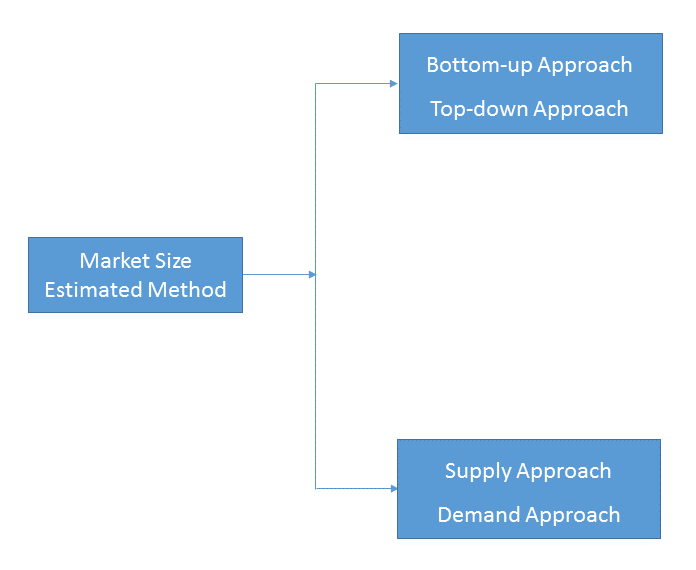
1)Top-down & Bottom-up Approach
Top-down approach uses a general market size figure and determines the percentage that the objective market represents.
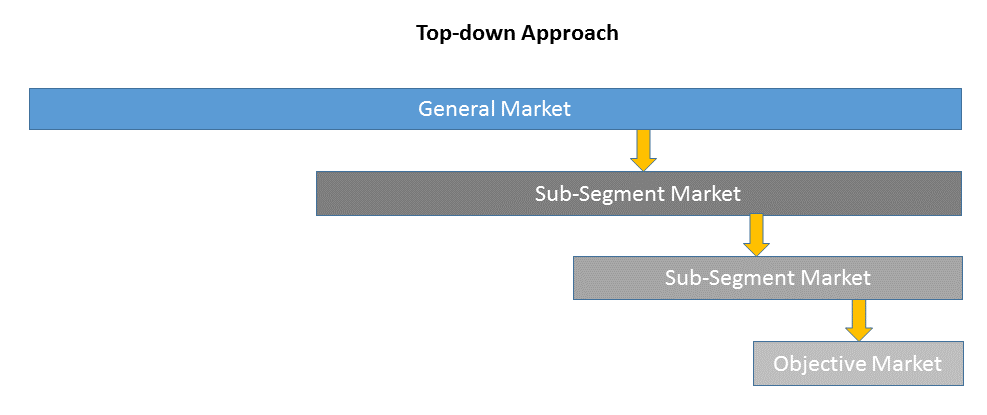
Bottom-up approach size the objective market by collecting the sub-segment information.

2)Supply & Demand Approach
Supply approach is based on assessments of the size of each competitor supplying the objective market.
Demand approach combine end-user data within a market to estimate the objective market size. It is sometimes referred to as bottom-up approach.
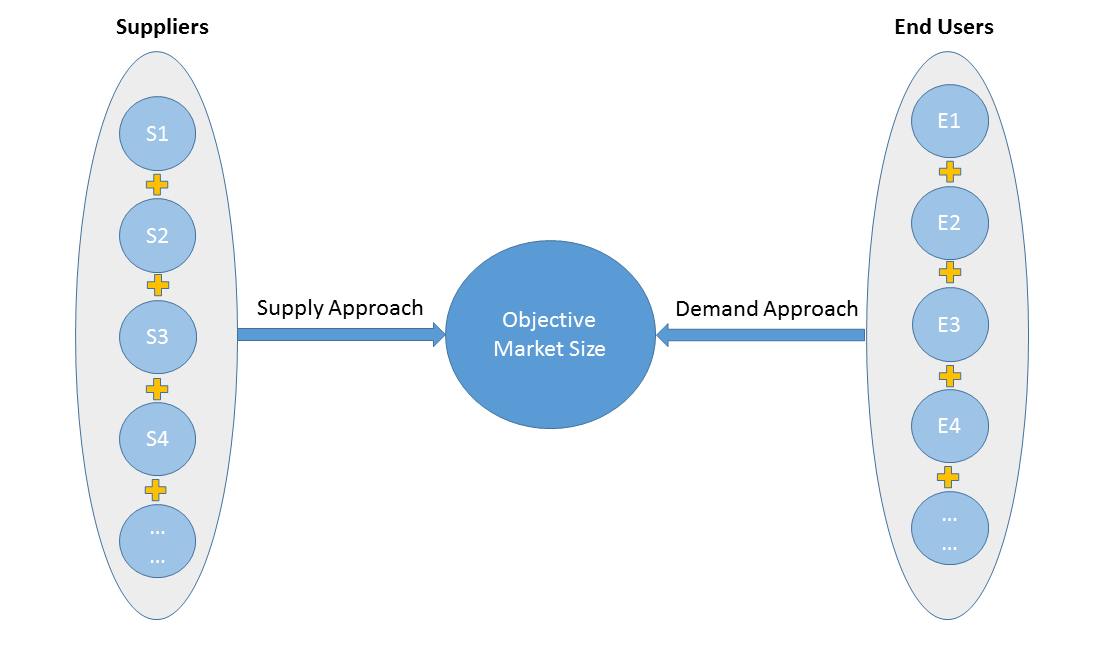
- Forecasting Methodology
- Numerous factors impacting the market trend are considered for forecast model:
- New technology and application in the future;
- New project planned/under contraction;
- Global and regional underlying economic growth;
- Threatens of substitute products;
- Industry expert opinion;
- Policy and Society implication.
- Analysis Tools
1)PEST Analysis
PEST Analysis is a simple and widely used tool that helps our client analyze the Political, Economic, Socio-Cultural, and Technological changes in their business environment.
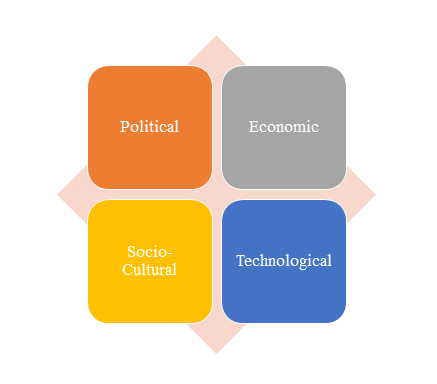
- Benefits of a PEST analysis:
- It helps you to spot business opportunities, and it gives you advanced warning of significant threats.
- It reveals the direction of change within your business environment. This helps you shape what you’re doing, so that you work with change, rather than against it.
- It helps you avoid starting projects that are likely to fail, for reasons beyond your control.
- It can help you break free of unconscious assumptions when you enter a new country, region, or market; because it helps you develop an objective view of this new environment.
2)Porter’s Five Force Model Analysis
The Porter’s Five Force Model is a tool that can be used to analyze the opportunities and overall competitive advantage. The five forces that can assist in determining the competitive intensity and potential attractiveness within a specific area.
- Threat of New Entrants: Profitable industries that yield high returns will attract new firms.
- Threat of Substitutes: A substitute product uses a different technology to try to solve the same economic need.
- Bargaining Power of Customers: the ability of customers to put the firm under pressure, which also affects the customer's sensitivity to price changes.
- Bargaining Power of Suppliers: Suppliers of raw materials, components, labor, and services (such as expertise) to the firm can be a source of power over the firm when there are few substitutes.
- Competitive Rivalry: For most industries the intensity of competitive rivalry is the major determinant of the competitiveness of the industry.
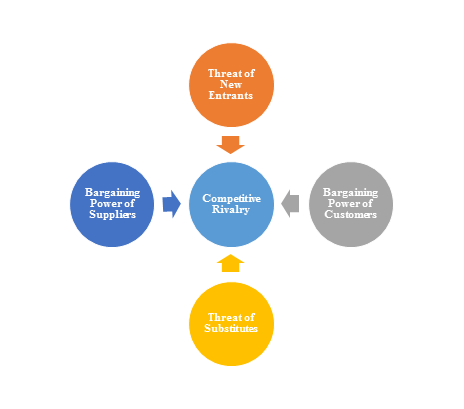
3)Value Chain Analysis
Value chain analysis is a tool to identify activities, within and around the firm and relating these activities to an assessment of competitive strength. Value chain can be analyzed by primary activities and supportive activities. Primary activities include: inbound logistics, operations, outbound logistics, marketing & sales, service. Support activities include: technology development, human resource management, management, finance, legal, planning.
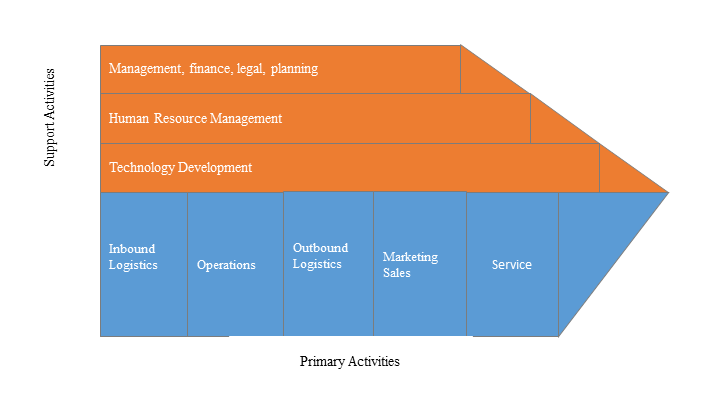
4)SWOT Analysis
SWOT analysis is a tool used to evaluate a company's competitive position by identifying its strengths, weaknesses, opportunities and threats. The strengths and weakness is the inner factor; the opportunities and threats are the external factor. By analyzing the inner and external factors, the analysis can provide the detail information of the position of a player and the characteristics of the industry.
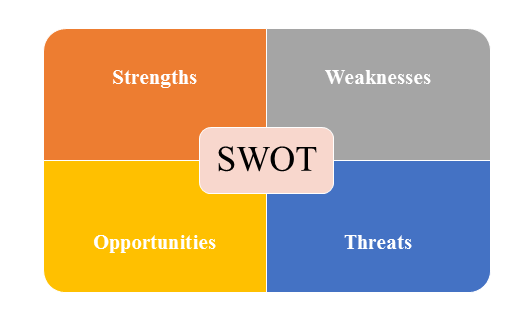
- Strengths describe what the player excels at and separates it from the competition
- Weaknesses stop the player from performing at its optimum level.
- Opportunities refer to favorable external factors that the player can use to give it a competitive advantage.
- Threats refer to factors that have the potential to harm the player.
- Data Sources
| Primary Sources | Secondary Sources |
|---|---|
| Face to face/Phone Interviews with market participants, such as: Manufactures; Distributors; End-users; Experts. Online Survey |
Government/International Organization Data: Annual Report/Presentation/Fact Book Internet Source Information Industry Association Data Free/Purchased Database Market Research Report Book/Journal/News |